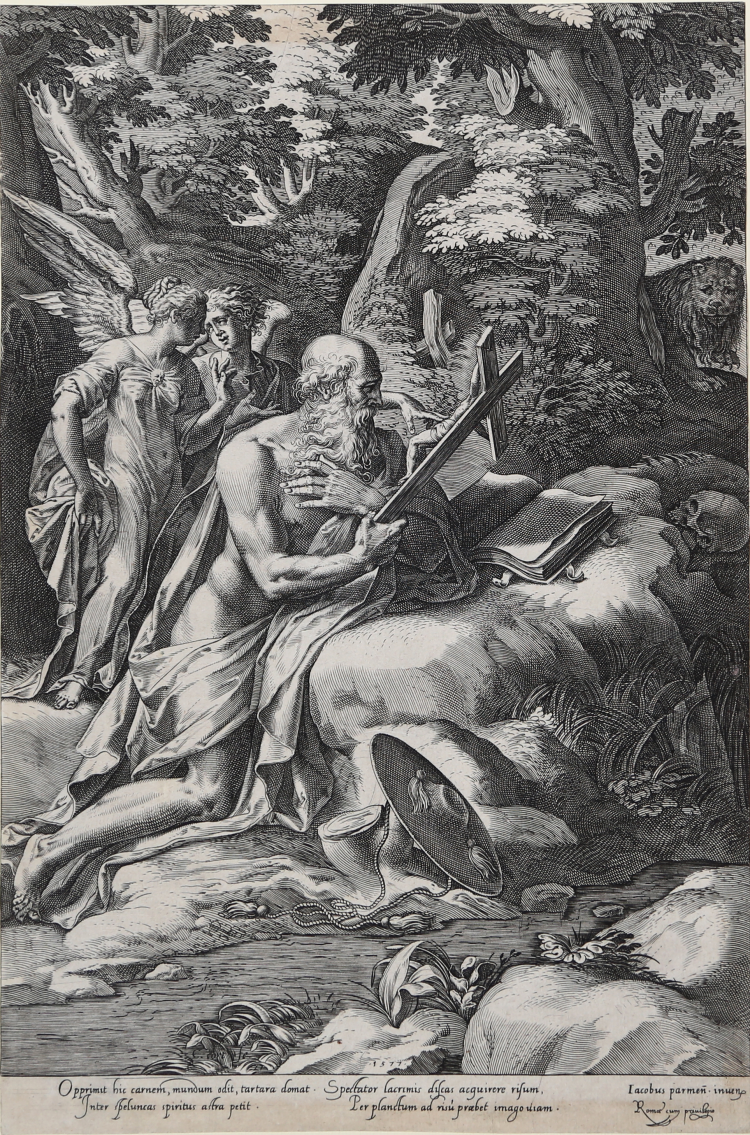




| Reference: | S30166 |
| Author | Cornelis CORT |
| Year: | 1577 |
| Measures: | 378 x 250 mm |



| Reference: | S30166 |
| Author | Cornelis CORT |
| Year: | 1577 |
| Measures: | 378 x 250 mm |
Engraving, 1577, signed and dated at lower center C. Cort fe. ; Iacobus parmen. inven . In lower margin, two Latin couplets: Opprimit hic carnem, mundum odit, tartara domat. /Inter speluncas spiritus astra petit. //Spectator lacrimis discas acquirere risum. / Per planctum ad risu praebet imago viam.
After Jacopo Zanguidi called Bertoja. Example of the second state of four with the address of the publisher Lorenzo Vaccari.
A fine impression, printed on contemporary laid paper, trimmed to the platemark, in very god conditions.
The work translates a lost painting by Bertoja, as described by De Grazia. Previously, the erroneous attribution, had traced the work after a painting by Jacopo Palma. Manfred Sellink describes a single copy of the first state, in Berlin, that was lost during the Second World War.
|
The New Hollstein, II, p. 145, 113 II/IV; TIB 52, 131; Witcombe, Print Publishing in Sixteenth-Century Rome, p. 343, 5.37.
|
Cornelis CORT (Hoorn, nr Alkmaar, 1533 - Roma, prima del 22 Aprile 1578)
|
North Netherlandish engraver and draughtsman, active in Flanders and Italy. His first documented works are a series of engravings issued by the Antwerp publisher Hieronymous Cock, beginning c. 1553. Cort may have been an apprentice within Cock’s establishment, as none of these prints was inscribed with his name until after the plates had passed out of Cock’s hands. A letter of 1567 to Titian from the Netherlandish writer and painter Domenicus Lampsonius (1532–99) describes Cock as Cort’s master. By 1560 Cort had developed a bold and strongly modelled sculptural style of engraving, influenced in part by the Italian Giorgio Ghisi, who worked for Cock between 1550 and 1555. Cort was particularly successful in reproducing the Italianate figure compositions of Frans Floris, after whom he engraved more than 50 prints, notably the Liberal Arts (seven prints; 1565) and the Labours of Hercules (ten prints; 1565). He also reproduced compositions by Maarten van Heemskerck, Andrea del Sarto, Rogier van der Weyden and others while working for Cock.
|
|
The New Hollstein, II, p. 145, 113 II/IV; TIB 52, 131; Witcombe, Print Publishing in Sixteenth-Century Rome, p. 343, 5.37.
|
Cornelis CORT (Hoorn, nr Alkmaar, 1533 - Roma, prima del 22 Aprile 1578)
|
North Netherlandish engraver and draughtsman, active in Flanders and Italy. His first documented works are a series of engravings issued by the Antwerp publisher Hieronymous Cock, beginning c. 1553. Cort may have been an apprentice within Cock’s establishment, as none of these prints was inscribed with his name until after the plates had passed out of Cock’s hands. A letter of 1567 to Titian from the Netherlandish writer and painter Domenicus Lampsonius (1532–99) describes Cock as Cort’s master. By 1560 Cort had developed a bold and strongly modelled sculptural style of engraving, influenced in part by the Italian Giorgio Ghisi, who worked for Cock between 1550 and 1555. Cort was particularly successful in reproducing the Italianate figure compositions of Frans Floris, after whom he engraved more than 50 prints, notably the Liberal Arts (seven prints; 1565) and the Labours of Hercules (ten prints; 1565). He also reproduced compositions by Maarten van Heemskerck, Andrea del Sarto, Rogier van der Weyden and others while working for Cock.
|